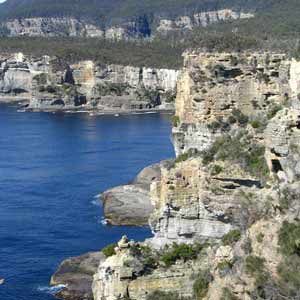Exploring The West Coast
The Rugged West Coast

The West Coast of Tasmania is very different to the East Coast. It has always been more isolated, less tamed, torn by fiercer weather, and so had to be self-reliant. Many outsiders have had difficulty understanding the historical context of the isolation of the west coast and its smaller communities. Initially the only way in and out was by sea, and a rail service was only available from the 1920s and no serviceable roads existed until the 1930s. This means that the region has fewer towns and villages, and more wilderness. In this modern era, the West Coast no longer suffers from a lack of good roads, and certainly lends itself well to a campervan adventure holiday.
From Hobart, as you drive along the Lyell Highway, you enter the West Coast by driving along into the Franklin-Gordon Wild Rivers National Park. The park is simply sensational, protecting the great rivers of the west including the Franklin, Gordon and Olga Rivers. Be warned, mobile phones are often out of contact with a tower once you enter the park (which just adds to the attraction for some).
The first town you will come to is Tarraleah, the Town in the Wilderness. Campervan accommodation is supplied by the Highland Caravan Park, with 27 powered sites; facilities include a kitchen, laundry, bathrooms and barbeques. If you are interested in Tasmanian art, craft or clothing, it is available in Tarraleah's Highland Store. The town has a golf course, and can supply opportunities for fishing hiking, and other wilderness activities.
Further along the highway is Derwent Bridge, sitting between Lake King William and Lake St Clair. Derwent Bridge is home to the Wall in the Wilderness, a massive sculptural undertaking of Huon pine panels, depicting the history of the Tasmanian wilderness. Near Derwent Bridge, you can visit Pumphouse Point on the Lake St Clair's south-eastern shore for breathtaking mountain views reflected in the lake.
There are a number of bushwalks that you can take from right by the highway, with the one that leads to the base of Nelson Falls an especially popular one. The more adventurous may be inclined to get involved in some white water rafting down the Franklin River, with some trips going for as long as fourteen days. Frenchmans Cap is visible through much of the park, and is a popular destination for experienced bushwalkers; the return trip to the summit takes four to five days.
The largest town of the West Coast is Queenstown, a mining town. After the lush foliage of the park, Queenstown is something of a shock. Due to logging for use in the smelters, the smelter fumes, and the heavy annual rainfall, there has been heavy erosion of the topsoil back to the harder rock beneath, which has contributed to the barren state of the surrounding countryside. The mountains surrounding Queenstown have unusual pink and grey hues, and very little in the way of vegetation. You can get a glimpse into the town's history by visiting the local museum. The Queenstown Heritage and Arts Festival is a biennial festival that celebrates the region's rich history.
Strahan sits on the shores of the Macquarie Harbour, about a forty minute drive from Queenstown, and is normally the next stage in a campervan journey. While Queenstown was a mining town, Strahan was a logging town and a seaport. Initially, Strahan was a base for the businessmen coming to seek out the Huon Pine that grows in these parts. Huon Pine is still in high demand because it is extremely durable, and there are a number of shops in Strahan where you can buy goods manufactured from it. A tour of Morrisons Huon Pine Mill will teach you more about the wood and its importance to the area. A penal colony was created at Sarah Island which lies offshore, and convicts would have to row to the mainland through the notorious 'Hells Gate' of Macquarie Harbour to harvest the pine. Boat trips can be taken to Sarah Island, to see the remains of the notorious penal settlement that had the reputation of being the harshest penal settlement in the Australian colonies. Much of Strahan's recreational activities are water-based, with canoeing and kayaking popular pursuits, and fishing also has its place in Strahan. The Strahan caravan park is just a 15min stroll from the town centre, and is close to the beach.
Zeehan was once known as the Silver City, and was in direct competition with Strahan as a seaport, and was the third largest city in Tasmania. Now that history lingers as the elegant buildings lining the main street, and as displays in the West Coast Heritage Centre, which used to be known as the West Coast Pioneers' Museum. The impressive Zeehan School of Mines and Metallurgy, built 1892, is now the town's museum and is also home to one of the finest collections of minerals in the world. The Gaiety Theatre of Zeehan was the largest concert hall and theatre in Australia when constructed in 1898, and had a seating capacity for over 1,000 patrons. The theatre can be inspected by people who buy tickets to the heritage centre.
With its rich history and its wealth of natural attractions, any journey you make through the west of Tassie is going to be an inspiring and interesting one. The towns mentioned here are only a taste of the places you can visit, the West Coast has so much more to offer, like the town of Corrina, gateway to the Tarkine Wilderness; the Wee Georgie Wood Steam Railway in Tullah; the town of Rosebery, the 'highest' postcode in Tasmania. And, with a campervan, you have the freedom to visit it all.

From Hobart, as you drive along the Lyell Highway, you enter the West Coast by driving along into the Franklin-Gordon Wild Rivers National Park. The park is simply sensational, protecting the great rivers of the west including the Franklin, Gordon and Olga Rivers. Be warned, mobile phones are often out of contact with a tower once you enter the park (which just adds to the attraction for some).
The first town you will come to is Tarraleah, the Town in the Wilderness. Campervan accommodation is supplied by the Highland Caravan Park, with 27 powered sites; facilities include a kitchen, laundry, bathrooms and barbeques. If you are interested in Tasmanian art, craft or clothing, it is available in Tarraleah's Highland Store. The town has a golf course, and can supply opportunities for fishing hiking, and other wilderness activities.
Further along the highway is Derwent Bridge, sitting between Lake King William and Lake St Clair. Derwent Bridge is home to the Wall in the Wilderness, a massive sculptural undertaking of Huon pine panels, depicting the history of the Tasmanian wilderness. Near Derwent Bridge, you can visit Pumphouse Point on the Lake St Clair's south-eastern shore for breathtaking mountain views reflected in the lake.
There are a number of bushwalks that you can take from right by the highway, with the one that leads to the base of Nelson Falls an especially popular one. The more adventurous may be inclined to get involved in some white water rafting down the Franklin River, with some trips going for as long as fourteen days. Frenchmans Cap is visible through much of the park, and is a popular destination for experienced bushwalkers; the return trip to the summit takes four to five days.
The largest town of the West Coast is Queenstown, a mining town. After the lush foliage of the park, Queenstown is something of a shock. Due to logging for use in the smelters, the smelter fumes, and the heavy annual rainfall, there has been heavy erosion of the topsoil back to the harder rock beneath, which has contributed to the barren state of the surrounding countryside. The mountains surrounding Queenstown have unusual pink and grey hues, and very little in the way of vegetation. You can get a glimpse into the town's history by visiting the local museum. The Queenstown Heritage and Arts Festival is a biennial festival that celebrates the region's rich history.
Strahan sits on the shores of the Macquarie Harbour, about a forty minute drive from Queenstown, and is normally the next stage in a campervan journey. While Queenstown was a mining town, Strahan was a logging town and a seaport. Initially, Strahan was a base for the businessmen coming to seek out the Huon Pine that grows in these parts. Huon Pine is still in high demand because it is extremely durable, and there are a number of shops in Strahan where you can buy goods manufactured from it. A tour of Morrisons Huon Pine Mill will teach you more about the wood and its importance to the area. A penal colony was created at Sarah Island which lies offshore, and convicts would have to row to the mainland through the notorious 'Hells Gate' of Macquarie Harbour to harvest the pine. Boat trips can be taken to Sarah Island, to see the remains of the notorious penal settlement that had the reputation of being the harshest penal settlement in the Australian colonies. Much of Strahan's recreational activities are water-based, with canoeing and kayaking popular pursuits, and fishing also has its place in Strahan. The Strahan caravan park is just a 15min stroll from the town centre, and is close to the beach.
Zeehan was once known as the Silver City, and was in direct competition with Strahan as a seaport, and was the third largest city in Tasmania. Now that history lingers as the elegant buildings lining the main street, and as displays in the West Coast Heritage Centre, which used to be known as the West Coast Pioneers' Museum. The impressive Zeehan School of Mines and Metallurgy, built 1892, is now the town's museum and is also home to one of the finest collections of minerals in the world. The Gaiety Theatre of Zeehan was the largest concert hall and theatre in Australia when constructed in 1898, and had a seating capacity for over 1,000 patrons. The theatre can be inspected by people who buy tickets to the heritage centre.
With its rich history and its wealth of natural attractions, any journey you make through the west of Tassie is going to be an inspiring and interesting one. The towns mentioned here are only a taste of the places you can visit, the West Coast has so much more to offer, like the town of Corrina, gateway to the Tarkine Wilderness; the Wee Georgie Wood Steam Railway in Tullah; the town of Rosebery, the 'highest' postcode in Tasmania. And, with a campervan, you have the freedom to visit it all.

